Essential Tools for Fitting Curtains
- Home
- Tools for Fitting Curtains
These are 3 essential tools you will need for fitting our curtain tracks. The first is a pair of step ladders to reach the required height. The second is a drill with a 6mm masonry drill bit. The third item is either a cordless drill/driver or a manual screwdriver for driving in the screws. There are some other things you may need but probably won't. However, it's useful to know about these just in case.
Some of these tools you may already have but if not try and borrow before you buy. That is unless you have plans for more DIY projects like this one.
These are 3 essential tools you will need for fitting our curtain tracks. The first is a pair of step ladders to reach the required height. The second is a drill with a 6mm masonry drill bit. The third item is either a cordless drill/driver or a manual screwdriver for driving in the screws. There are some other things you may need but probably won't. However, it's useful to know about these just in case.
Some of these tools you may already have but if not try and borrow before you buy. That is unless you have plans for more DIY projects like this one.
Things you will need!
Before anyone says it - NO, I don't get commision from Screwfix or Toolstation for these recommendations below :-)
I just want to highlight the stuff I have used and found to be good from 30 years of fitting and hanging curtains. I hope this helps. All these items below are my own
Stepladders
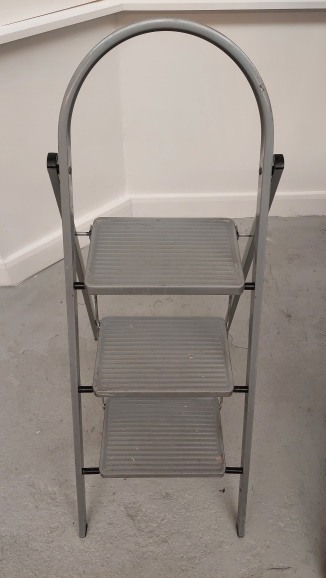
I personally use these steel step ladders from Toolstation. They are heavier than the aluminum versions but a lot stronger.
They are really sturdy and there is no danger of them collapsing under my weight.
These work well for me as I can comfortably reach a good working height for most windows. I rarely stand on the top step as I like to use that as my tool shelf. I keep my drill/driver screws and plugs all within easy reach.
Which means a little less time stepping up and down to collect things. However, it's always handy having someone else around to pick up the stuff I always seem to drop :-)
In some bedroom bays the bay ceiling is so low you can simply reach up. This for me is heaven :-)
Cordless Drill
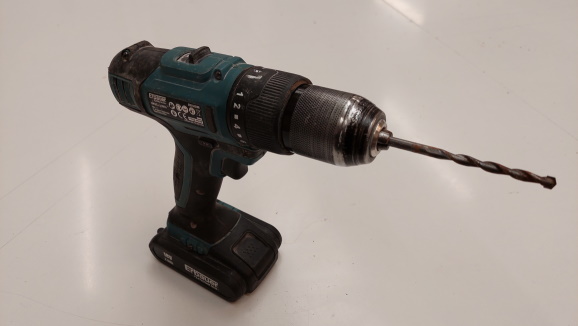
I personally use this cordless drill from Screwfix. It's their own brand "Erbuaer". It has served me well but you can use any make or model. You can just use a regular version with a power cable if you have one already.
What's more important is the drill bit. Do yourself a favour and buy a new drill bit for this job. Again I use Screwfix own brand drill bits. These for the money are great and do the job of drill bits costing twice the price. You will need a masonry drill bit with a 6mm diameter.
Cordless Driver
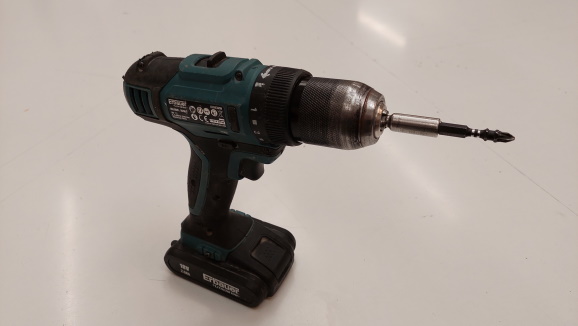
I use the matching "Erbuaer" driver as I bought it as a set with the drill. You can simply use a regular screwdriver. It will just take a little longer.
If I'm fitting bay tracks on my own I find using the cordless driver a lot easier. You will need these driver bits to match the screws I supply. You may have the right size, so just check with the screws before you buy another.
Things you might need!
Spirit Level
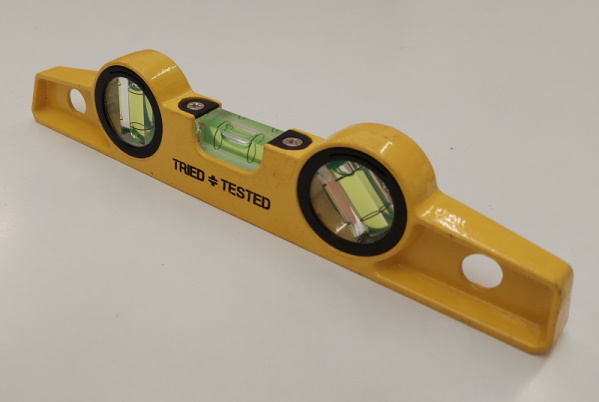
I have a range of large spirit levels but hardly ever use them. What I do have and use regularly is a mini spirit level. I find this very handy when leveling up the track returns on bay windows. Sometimes I just do this by eye.
I even use it on wider straight windows. I hold the track up to the wall over the window and hold the mini spirit level on top of the track.
I also have a laser spirit level that project a red line on to the wall. Having said that I would not recommend you buy one of these just to fit tracks on a couple of windows. However, if uncle Bill has one then speak nicely to him and buy him a pint :-)
Other drill bits
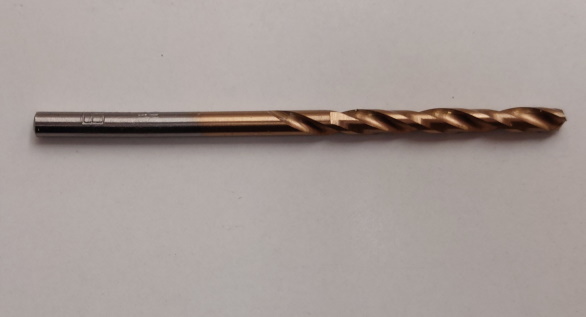
When ceiling fixing a curtain track especially in a bay window. You may find the masonry drill bit hits something solid. Occasionally if might be concrete but more often than not it will be a steel lintel.
On bays these are on located at the front of the bay just before the room starts. They hold the wall above the bay up.
So this is where you will need to use a drill bit that will cut holes in steel lintels. I have used many different kinds of steel cutting bits over the years. However, I keep coming back to these HSS drill bits from Screwfix. Always pre drill the plaster using a masonry drill bit first. Then use the HSS drill bits (not on hammer action). Believe it or not using the HSS drill bits to cut a hole in plaster will blunt the tip really quickly (go figure?).
Other fixings
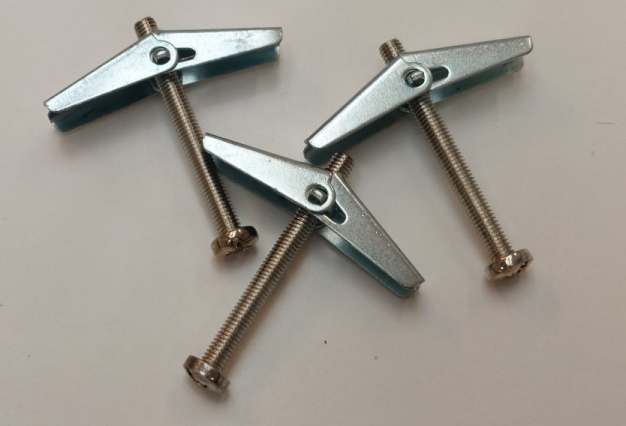
If you are really unlucky and you are trying to fix a bay track to the ceiling within your bay and it turns out to be made of lathe and plaster (original ceilings in old houses). Then you may need to use these Toggle fixings from Toolstation.
When faced with ceiling like this I start by driving the screws straight in. Sometimes you hit a nice lathe (thin strip of timber). This can be sufficient to grip the bracket. This is where ordering a few extra brackets with your track pays dividends. If this does not grip the bracket well enough. Then move onto using the toggle fixings.
You will need an 8mm diameter drill bit to create the ight size hole for these to pass through. The arms are spring loaded and fold down. Then pop open once they pass through the ceiling.
I will make a video soon showing how these work with fitting ceiling tracks. The truth is that fixing to lather and plaster ceilings is never going to be as good as fixing to a modern plasterboard ceiling. However, it can still be perfectly doable. Just don't expect to hang the worlds heaviest curtains.
There are many other fixings out there but in my opinion you should not need to use them.
Things you won't need!
Screws and plugs
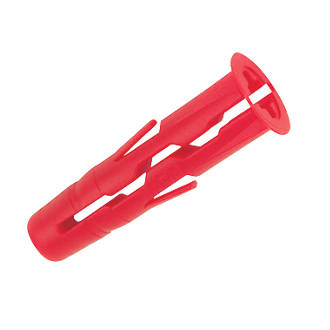
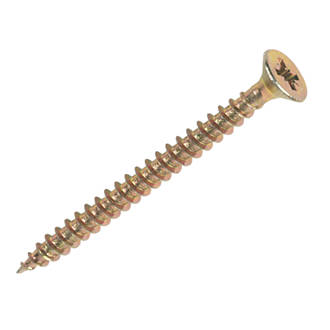
If you buy any of our curtain tracks you won't need to find or buy any screws or plugs. We supply top quality ones with every track we sell.
Unlike the rubbish you get with DIY store style curtain tracks.
I personally have used these screws and plugs for many years. When it comes to successfully fitting tracks either to walls or ceilings. These will complete the job 95% of the time.
You will be very surprised how well this conbination grip a curtain track to the ceiling within a bay. It will be more than adequate for all but the heaviest domestic style curtains.
I'm not saying that if you made a real concerted effort to pull the curtains down that you couldn't. You will be able to with a lot of effort.
However, if this were to happen to you. Would you prefer the track and curtains to end up on the floor ready to be refitted. Or would you prefer it brought the celing down with the curtains and track?
And before anyone says "I will just locate and fit all the brackets to the wooden joists in the ceiling". Good luck with that as most joists are not located anywhere you will need them to be. Most of your fixings will be into plasterboard.
This is why we supply bay tracks with brackets spaced approximately every 30cm (often less depending on shape). On straight track brackets spaced every 40cm.
This means the curtain weight will be more evenly distributed over more brackets. So each bracket has to carry less weight.
Well I think that covers most of the items you will or might need when it comes to fitting curtain hardware. So if you haven't aleady seen our custom made bay window curtain tracks. Then why not take a look and you can use the bay track calculator to work out a price for one to fit your bay perfectly.
- Home
- Tools for Fitting Curtains
Things you will need!
Before anyone says it - NO, I don't get commision from Screwfix or Toolstation for these recommendations below :-)
I just want to highlight the stuff I have used and found to be good from 30 years of fitting and hanging curtains. I hope this helps. All these items below are my own
Stepladders

I personally use these steel step ladders from Toolstation. They are heavier than the aluminum versions but a lot stronger.
They are really sturdy and there is no danger of them collapsing under my weight.
These work well for me as I can comfortably reach a good working height for most windows. I rarely stand on the top step as I like to use that as my tool shelf. I keep my drill/driver screws and plugs all within easy reach.
Which means a little less time stepping up and down to collect things. However, it's always handy having someone else around to pick up the stuff I always seem to drop :-)
In some bedroom bays the bay ceiling is so low you can simply reach up. This for me is heaven :-)
Cordless Drill

I personally use this cordless drill from Screwfix. It's their own brand "Erbuaer". It has served me well but you can use any make or model. You can just use a regular version with a power cable if you have one already.
What's more important is the drill bit. Do yourself a favour and buy a new drill bit for this job. Again I use Screwfix own brand drill bits. These for the money are great and do the job of drill bits costing twice the price. You will need a masonry drill bit with a 6mm diameter.
Cordless Driver

I use the matching "Erbuaer" driver as I bought it as a set with the drill. You can simply use a regular screwdriver. It will just take a little longer.
If I'm fitting bay tracks on my own I find using the cordless driver a lot easier. You will need these driver bits to match the screws I supply. You may have the right size, so just check with the screws before you buy another.
Things you might need!
Spirit Level

I have a range of large spirit levels but hardly ever use them. What I do have and use regularly is a mini spirit level. I find this very handy when leveling up the track returns on bay windows. Sometimes I just do this by eye.
I even use it on wider straight windows. I hold the track up to the wall over the window and hold the mini spirit level on top of the track.
I also have a laser spirit level that project a red line on to the wall. Having said that I would not recommend you buy one of these just to fit tracks on a couple of windows. However, if uncle Bill has one then speak nicely to him and buy him a pint :-)
Other drill bits

When ceiling fixing a curtain track especially in a bay window. You may find the masonry drill bit hits something solid. Occasionally if might be concrete but more often than not it will be a steel lintel.
On bays these are on located at the front of the bay just before the room starts. They hold the wall above the bay up.
So this is where you will need to use a drill bit that will cut holes in steel lintels. I have used many different kinds of steel cutting bits over the years. However, I keep coming back to these HSS drill bits from Screwfix. Always pre drill the plaster using a masonry drill bit first. Then use the HSS drill bits (not on hammer action). Believe it or not using the HSS drill bits to cut a hole in plaster will blunt the tip really quickly (go figure?).
Other fixings

If you are really unlucky and you are trying to fix a bay track to the ceiling within your bay and it turns out to be made of lathe and plaster (original ceilings in old houses). Then you may need to use these Toggle fixings from Toolstation.
When faced with ceiling like this I start by driving the screws straight in. Sometimes you hit a nice lathe (thin strip of timber). This can be sufficient to grip the bracket. This is where ordering a few extra brackets with your track pays dividends. If this does not grip the bracket well enough. Then move onto using the toggle fixings.
You will need an 8mm diameter drill bit to create the ight size hole for these to pass through. The arms are spring loaded and fold down. Then pop open once they pass through the ceiling.
I will make a video soon showing how these work with fitting ceiling tracks. The truth is that fixing to lather and plaster ceilings is never going to be as good as fixing to a modern plasterboard ceiling. However, it can still be perfectly doable. Just don't expect to hang the worlds heaviest curtains.
There are many other fixings out there but in my opinion you should not need to use them.
Things you won't need!
Screws and plugs


If you buy any of our curtain tracks you won't need to find or buy any screws or plugs. We supply top quality ones with every track we sell.
Unlike the rubbish you get with DIY store style curtain tracks.
I personally have used these screws and plugs for many years. When it comes to successfully fitting tracks either to walls or ceilings. These will complete the job 95% of the time.
You will be very surprised how well this conbination grip a curtain track to the ceiling within a bay. It will be more than adequate for all but the heaviest domestic style curtains.
I'm not saying that if you made a real concerted effort to pull the curtains down that you couldn't. You will be able to with a lot of effort.
However, if this were to happen to you. Would you prefer the track and curtains to end up on the floor ready to be refitted. Or would you prefer it brought the celing down with the curtains and track?
And before anyone says "I will just locate and fit all the brackets to the wooden joists in the ceiling". Good luck with that as most joists are not located anywhere you will need them to be. Most of your fixings will be into plasterboard.
This is why we supply bay tracks with brackets spaced approximately every 30cm (often less depending on shape). On straight track brackets spaced every 40cm.
This means the curtain weight will be more evenly distributed over more brackets. So each bracket has to carry less weight.
Well I think that covers most of the items you will or might need when it comes to fitting curtain hardware. So if you haven't aleady seen our custom made bay window curtain tracks. Then why not take a look and you can use the bay track calculator to work out a price for one to fit your bay perfectly.
- Home
- Tools for Fitting Curtains